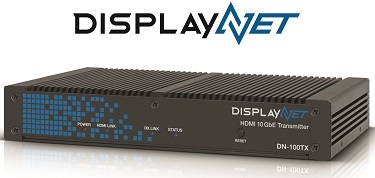5 AV Predictions Rooted in Realism

It's December, the season of icy windshields and regrettable Santa sweaters. For some, 2016 has been a year to erase from the history books, nonetheless, there have been significant developments in the professional AV industry that warrant reflection, attention, and, yes, a snarky listicle. I’m not going to focus on Samsung’s Harman acquisition, USB-C, Thunderbolt 3, or get in the weeds with iterative refinements. That’s all exciting and certainly notable, but these are the broader trend I see evolving next year, informing what kinds of problems we can solve and potential products to put on our capital budget lists.

DVI Gear’s DisplayNet leverages 10GbE to distribute high-res uncompressed AV signals up to 4K. (1) AV-over-IP is about more than endpoints. Enter the ecosystem.
Not only are more products network-capable for audio and video (speakers, digital signage, etc), there are more cohesive efforts to support the AV-over-Ethernet architecture. Exhibit A: The new SDVoE Alliance. The SDVoE products share the IEEE 802.3 Ethernet; alliance members represent the whole ecosystem, from chip manufacturers to endpoints and software. What I like about this development is the focus on an open-source style collaboration and cost-effective price points. We need to continue training and educating our community; AV-over-Ethernet is still unfamiliar turf for a lot of AV-centric folks. What’s more, in 2017, the infrastructure will come into sharper focus. As the industry's experience with AV-over-IP matures, "the benefits of using an uncompressed AV-over-10GbE solution" will be even clearer, Joseph Barbier of DVI Gear argues. "At the center of its many capabilities, DisplayNet leverages 10GbE to distribute high-resolution uncompressed AV signals up to 4K,” he says. Professional AV environments require perfect image quality with zero compression artifacts and zero frame latency. "DisplayNet delivers both,” Barbier adds.
(2) Tech managers will have more influence in 2017.
Year after year, the InfoComm International Economic Snapshot shows that the end-user influence is becoming more important in the AV process. From conducting needs analysis to RFPs to supporting in-house installation teams, tech managers are making more higher-level decisions. Of course we honor and adore our AV integration partners, and stats show that the vast majority of tech managers partner with consultants and third-parties on larger, complex projects. But our community is more knowledgeable than ever before. More departments are taking their AV in-house, and groups like CCUMC, the AV User Group, and our NewBay AV/IT Summits are equipping tech managers with roadmaps. Some university friends of mine even have AV programmers on staff. And, as AV and IT processes and "ownership" continue to merge, creating hybrid departments that might have been unrecognizable a decade ago, isn’t it the tech manager who is the best positioned to create efficiencies, not a third-party integrator?
(3) Collaboration realism.
The analog sun has set—old news. But it’s pure fiction that the analog dawn has magically swung open the door to wireless BYOD paradise. At many campuses large and small, tech managers are still keeping track of their VGA adapters and supporting rooms with projectors, VCRs (yes), and dusty smartboards with clunky controls. But as legacy systems reach their ends-of-life and wireless systems come down in price, cable-free BYOD solutions are topping many wish lists this year. Wireless presentation systems are nothing new, but I’m continually amazed by how smart and intuitive they are getting. Huddle spaces and wireless systems are some of the most exciting and transformative technologies across the vertical markets, but especially in education and the enterprise. Big questions remain though: when you have 1,200 employees to support or 310 classrooms to update on a five-year refresh cycle, what’s your roll-out strategy? How many systems do you want/need per floor, per building? How will you keep your wireless content secure? Who "owns” and supports your wireless collaboration solutions…the IT department, the AV department, both?
(4) Live streaming = access.
With live streaming, organizations can share important events with institutional stakeholders who cannot be on site. From lectures to sports to executive briefings, live streaming will continue its rapid uptick in 2017. But with new opportunities comes new challenges: HEVC? Loyal to H.264? At what scale will you deploy your live streaming?
(5) Data-driven AV.
IoT is only one part of the ProAV+data story. As my colleague Cindy Davis astutely observed, “By gathering data on how the space is used, valuable information about the needs of the organization can be derived to make the space more effective and increase the return on investment of the space.” This is why we’ve created the AV/IT Technology Leadership Summit with a big focus on big data. In 2017 we will host four AV/IT summits (San Diego, Santa Clara, Denver, and Charleston). Stay tuned for more info and download our special ebook.
AV Technology’s editorial director Margot Douaihy has reported on the pro AV industry for sixteen years. At Franklin Pierce University, she teaches and tests out the latest LMS / AV technologies.
A daily selection of features, industry news, and analysis for AV/IT professionals. Sign up below.
The AVNetwork staff are storytellers focused on the professional audiovisual and technology industry. Their mission is to keep readers up-to-date on the latest AV/IT industry and product news, emerging trends, and inspiring installations.
